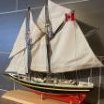-
Posts
2,482 -
Joined
-
Last visited
Reputation Activity
-
 JSGerson got a reaction from Geoff Matson in USS Constitution by JSGerson - Model Shipways Kit No. MS2040
JSGerson got a reaction from Geoff Matson in USS Constitution by JSGerson - Model Shipways Kit No. MS2040
Another spar support beam was added complete with diagonal knees at the bulwarks where the bitts are located. The bitts in actuality, passes vertically through the planking of the spar deck. This wasn’t done on the model as they won’t be seen as a continuous structure and would just add another layer of complexity to the build. Therefore, the vertical column stopped at the top surface of the spar deck support beam. If all goes well, the bitts on the spar deck will be glued directly over the gun deck bitts without any adjustment. If not, there will be some wiggle room and any slight misalignments won’t be noticed (if all goes well).
The rollers were constructed as before for the foremast bitts. A hole was drilled to accept the cross beam. The brass rod slips inside the brass tube. The brackets were made from the brass sheet after a hole was punched into it for each bracket. Then the brass sheet was cut to size and bent to shape. Each wooden bitt was made of two pieces of stained (gunstock) boxwood cut to shape. The vertical pieces with the roller assembly were installed first. Once the glue dried, the diagonal braces were added to ensure a proper fit to the vertical and horizontal surfaces.
-
 JSGerson got a reaction from GGibson in USS Constitution by JSGerson - Model Shipways Kit No. MS2040
JSGerson got a reaction from GGibson in USS Constitution by JSGerson - Model Shipways Kit No. MS2040
Gregg, well I don't have ALL the resources, but I do have a bunch😛
As for printing them out full size, I haven't done that as it is costly and inconvenient. I did have the kit's plans copied full size so I could mark them up, fold them in torturous ways, and if they get damaged, no worries.
I print out what I need on a regular inkjet printer on standard paper using PowerPoint. When I need to print to model scale, it's by trial and error because PowerPoint can't print to a given scale on command. Additionally, I may need to tape together multiple sheets to get the desired printed image, which I admit is a crude method. Most of the time I just zoom in and out on the computer screen. The US Navy plans have the actual full scale dimensions so it's just a matter of scaling down the numbers for a lot of things.
Jon
-
 JSGerson got a reaction from bthoe in USS Constitution by JSGerson - Model Shipways Kit No. MS2040
JSGerson got a reaction from bthoe in USS Constitution by JSGerson - Model Shipways Kit No. MS2040
At this point I installed the last of the gun deck furniture previously made four years ago:
double pump quad pump sea chest scuttlebutt & table grog cask & table harness cask Still to come, the remaining spar beams and associate accoutrements to support the main hatch.
-
 JSGerson got a reaction from Geoff Matson in USS Constitution by JSGerson - Model Shipways Kit No. MS2040
JSGerson got a reaction from Geoff Matson in USS Constitution by JSGerson - Model Shipways Kit No. MS2040
Getting back to the ladder hand ropes, I left the messenger rope loose on the deck as if it had just been released from the cable or chain and the ladders were put back in place. Technically, either the messenger is in place, or the hatch covers and ladders are in use, not both at the same time. In either case, it’s all going to be difficult to see and the layman certainly won’t know anything looks out of place.
Next, more spar deck supports and their associated diagonal knees at their bulwarks were installed aft of the capstan. Additionally, some “temporary” (as marked on the US Navy plans) supports (painted white) were added as well. It’s getting really crowded on the gun deck.
-
 JSGerson got a reaction from Geoff Matson in USS Constitution by JSGerson - Model Shipways Kit No. MS2040
JSGerson got a reaction from Geoff Matson in USS Constitution by JSGerson - Model Shipways Kit No. MS2040
The messenger rope was installed first since it was wrapped around the capstan. A spliced loop end was created for each end of the messenger rope first. Then the rope was wrapped around the capstan three complete times. The rope went along the gun deck to the bow around a support and back again towards the capstan. There would have been a roller mechanism for this at the apex of the turn in the actual ship, but that will not be seen in this model. The two end loops of the messenger rope were then lashed together. The lashing had to be done using needle and thread in the confined space of the model and was a bit delicate to do.
The anchor cable and anchor chain were inserted through their respective hawser holes in the bow, down the length of the deck using anchor chain guides previously installed, and into the pipe in the gun deck. Neither ends of the cable nor chain were permanently installed pending attachment of their anchors at a later date.
Oh, I also installed the framework for the main mast so it has a rake of 3.5 degrees.
-
 JSGerson got a reaction from Geoff Matson in USS Constitution by JSGerson - Model Shipways Kit No. MS2040
JSGerson got a reaction from Geoff Matson in USS Constitution by JSGerson - Model Shipways Kit No. MS2040
When I last worked on the gun deck capstan, I left it in such a manner that I could fine tune its height to the proper length when I knew how long it had to be. With the spar beam dry fitted above it, the capstan was cut and sanded to its final height and installed (shown without the spar beams).
-
 JSGerson got a reaction from PaddyO in USS Constitution by JSGerson - Model Shipways Kit No. MS2040
JSGerson got a reaction from PaddyO in USS Constitution by JSGerson - Model Shipways Kit No. MS2040
The remainder of the main grating was sliced lengthwise. One half remained intact, while the other was cut again into individual gratings. It is to be noted that there are six different size gratings that comprise the 18 total on the single laser cut piece. So as not to mix them up, I only cut off what I needed, before I moved on to the next one using them to set the next beam frame in turn.
The internal framing was made from various pieces of 5/16” x 1/16” boxwood which I had to mill myself on the Byrne’s Saw. The supplemental wood package was based on the practicum which did not address removing grating to reveal underling structure.
Using 1/8”x1/32” boxwood, the internal lip was created to support the intact remaining long grating as well as the individual open frameworks. Finally, the assembly was stained and painted. The last components to be added to the main grating frame were the six eyebolt and rings assemblies.
-
 JSGerson got a reaction from PaddyO in USS Constitution by JSGerson - Model Shipways Kit No. MS2040
JSGerson got a reaction from PaddyO in USS Constitution by JSGerson - Model Shipways Kit No. MS2040
The Main Grating
If I was following the kit instructions (what there is of them), the main grating would be very simple; just build a border around the laser cut main grating provided by the kit and it would be done.
If I were following the practicum, it’s a bit more complicated. Mr. Hunt would have you slice the grating lengthwise and add a support beam down the length of the full grating using complex lap joints.
But, if you plan on leaving half of the gratings open, and adding ladders to the gun deck so that the gun deck can be viewed, it’s almost a complete scratch build.
The exterior border frame, which is taller than the other grating frames, was fabricated just like all the other frames using the boxwood pieces (provided by the wood supplement package). The 5/16” x 3/32” boxwood was cut as follows:
2 pieces: 6 9/16” lengthwise 2 pieces: 2 5/32” beam wise These pieces were glued together with butt joints creating a large open frame.
Next, I held my breath as I cut off the four most forward gratings with the Byrnes Saw. These were used to set the first internal beam frame. The two outer corner gratings will remain off the framework to allow the installation of ladders to the gun deck.
-
 JSGerson got a reaction from GGibson in USS Constitution by JSGerson - Model Shipways Kit No. MS2040
JSGerson got a reaction from GGibson in USS Constitution by JSGerson - Model Shipways Kit No. MS2040
Dputxler, you can get the US Navy plans here:
https://ussconstitutionmuseum.org/discover-learn/modeler-resources/
Jon
-
 JSGerson got a reaction from Geoff Matson in USS Constitution by JSGerson - Model Shipways Kit No. MS2040
JSGerson got a reaction from Geoff Matson in USS Constitution by JSGerson - Model Shipways Kit No. MS2040
At this point I installed the last of the gun deck furniture previously made four years ago:
double pump quad pump sea chest scuttlebutt & table grog cask & table harness cask Still to come, the remaining spar beams and associate accoutrements to support the main hatch.
-
 JSGerson got a reaction from Unegawahya in USS Constitution by JSGerson - Model Shipways Kit No. MS2040
JSGerson got a reaction from Unegawahya in USS Constitution by JSGerson - Model Shipways Kit No. MS2040
Getting back to the ladder hand ropes, I left the messenger rope loose on the deck as if it had just been released from the cable or chain and the ladders were put back in place. Technically, either the messenger is in place, or the hatch covers and ladders are in use, not both at the same time. In either case, it’s all going to be difficult to see and the layman certainly won’t know anything looks out of place.
Next, more spar deck supports and their associated diagonal knees at their bulwarks were installed aft of the capstan. Additionally, some “temporary” (as marked on the US Navy plans) supports (painted white) were added as well. It’s getting really crowded on the gun deck.
-
 JSGerson got a reaction from Unegawahya in USS Constitution by JSGerson - Model Shipways Kit No. MS2040
JSGerson got a reaction from Unegawahya in USS Constitution by JSGerson - Model Shipways Kit No. MS2040
The messenger rope was installed first since it was wrapped around the capstan. A spliced loop end was created for each end of the messenger rope first. Then the rope was wrapped around the capstan three complete times. The rope went along the gun deck to the bow around a support and back again towards the capstan. There would have been a roller mechanism for this at the apex of the turn in the actual ship, but that will not be seen in this model. The two end loops of the messenger rope were then lashed together. The lashing had to be done using needle and thread in the confined space of the model and was a bit delicate to do.
The anchor cable and anchor chain were inserted through their respective hawser holes in the bow, down the length of the deck using anchor chain guides previously installed, and into the pipe in the gun deck. Neither ends of the cable nor chain were permanently installed pending attachment of their anchors at a later date.
Oh, I also installed the framework for the main mast so it has a rake of 3.5 degrees.
-
 JSGerson got a reaction from Unegawahya in USS Constitution by JSGerson - Model Shipways Kit No. MS2040
JSGerson got a reaction from Unegawahya in USS Constitution by JSGerson - Model Shipways Kit No. MS2040
When I last worked on the gun deck capstan, I left it in such a manner that I could fine tune its height to the proper length when I knew how long it had to be. With the spar beam dry fitted above it, the capstan was cut and sanded to its final height and installed (shown without the spar beams).
-
 JSGerson got a reaction from Geoff Matson in USS Constitution by JSGerson - Model Shipways Kit No. MS2040
JSGerson got a reaction from Geoff Matson in USS Constitution by JSGerson - Model Shipways Kit No. MS2040
Determination of the Anchor Cable and Messenger Cable Size
The question arose: what size is the messenger cable? First, I had to determine the size of the anchor cable. Step one as indicated below, I found on another builder’s log who was quoting one of the historical ship building books of old. Sorry, didn’t record that either.
1. “The Circumference of the anchor cable = 0.62 the Diameter of the mainmast”
2. Main Mast Diameter (US Navy plans) = 32” (full scale)
3. Anchor cable Circumference = 0.62 x 32” = 19.84” (0.258” scale)
4. Anchor cable Diameter = C/π = 0.258”/3.14159 = 0.082”
5. Guestimate that the messenger cable is ½ the Diameter of the Anchor Cable = 0.041” (3” full size)
I could not find the rule for messenger cable size, so it was assumed the messenger cable diameter had to be small enough to wrap around the capstan and still be strong enough to pull either the cable or chain.
In my stock, I have Syren Ship Model miniature tan rope sizes 0.080” and 0.035” for the anchor cable and messenger cable respectfully which should work for the model.
-
 JSGerson got a reaction from Geoff Matson in USS Constitution by JSGerson - Model Shipways Kit No. MS2040
JSGerson got a reaction from Geoff Matson in USS Constitution by JSGerson - Model Shipways Kit No. MS2040
I ran into a couple of surprises that although I had thought about them before, I overlooked in the end. When the capstan is engaged, anything that would interfere with the capstan operation and anchor cable/chain are in the clear, like hatch covers are in place and ladders are stowed away. In my case, I fabricated the hand ropes and stanchions for the ladders going down to the berth deck next to the gun deck capstan. As built, they would interfere with the messenger cable wrapping around the capstan. Also, I forgot to create the ladders going up to the spar deck for the open capstan hatchway, which I took care of.
One of the infamous Murphy’s Laws states: that no matter what you must do, you must do something else first. In this case I must install more supporting spar beams and their associated diagonal knees at the bulwarks as well as their support columns. But the more beams I install, the more difficult it becomes to install other items on the gun deck. Therefore, I’m constantly checking the sequence of fabrication and installation.
While I’m doing this, I decided it was time to lay down an anchor cable and an anchor chain. There are three anchors that came with the MS kit. One will be attached to the anchor chain, the second one to the anchor cable, and the third will be stowed on the deck.
The anchor chain that came with the kit has single links, but according to the photographs of the ship when she last used her anchor in the 1930s, she had a cross-linked chain. Today those chains are being used for mooring. I bought such a chain off the internet a year or so ago and unfortunately neglected to record where I purchased it from. The chain metal appears to be copper which required that it be blackened. The picture below shows the chain after it was blackened and drying.
-
 JSGerson got a reaction from Unegawahya in USS Constitution by JSGerson - Model Shipways Kit No. MS2040
JSGerson got a reaction from Unegawahya in USS Constitution by JSGerson - Model Shipways Kit No. MS2040
At this point I installed the last of the gun deck furniture previously made four years ago:
double pump quad pump sea chest scuttlebutt & table grog cask & table harness cask Still to come, the remaining spar beams and associate accoutrements to support the main hatch.
-
 JSGerson got a reaction from mtbediz in USS Constitution by JSGerson - Model Shipways Kit No. MS2040
JSGerson got a reaction from mtbediz in USS Constitution by JSGerson - Model Shipways Kit No. MS2040
Very sharp eyes! Yes, I spotted that too. luckily the pumps were only dry fitted when the photo was taken. That misplacement was corrected almost as soon as I made my posting. I didn't think any one would notice. I appreciate your attention to the details. Thanks!
Jon
-
 JSGerson got a reaction from Stevenleehills in USS Constitution by JSGerson - Model Shipways Kit No. MS2040
JSGerson got a reaction from Stevenleehills in USS Constitution by JSGerson - Model Shipways Kit No. MS2040
At this point I installed the last of the gun deck furniture previously made four years ago:
double pump quad pump sea chest scuttlebutt & table grog cask & table harness cask Still to come, the remaining spar beams and associate accoutrements to support the main hatch.
-
 JSGerson got a reaction from PaddyO in USS Constitution by JSGerson - Model Shipways Kit No. MS2040
JSGerson got a reaction from PaddyO in USS Constitution by JSGerson - Model Shipways Kit No. MS2040
At this point I installed the last of the gun deck furniture previously made four years ago:
double pump quad pump sea chest scuttlebutt & table grog cask & table harness cask Still to come, the remaining spar beams and associate accoutrements to support the main hatch.
-
 JSGerson got a reaction from Stevenleehills in USS Constitution by JSGerson - Model Shipways Kit No. MS2040
JSGerson got a reaction from Stevenleehills in USS Constitution by JSGerson - Model Shipways Kit No. MS2040
Getting back to the ladder hand ropes, I left the messenger rope loose on the deck as if it had just been released from the cable or chain and the ladders were put back in place. Technically, either the messenger is in place, or the hatch covers and ladders are in use, not both at the same time. In either case, it’s all going to be difficult to see and the layman certainly won’t know anything looks out of place.
Next, more spar deck supports and their associated diagonal knees at their bulwarks were installed aft of the capstan. Additionally, some “temporary” (as marked on the US Navy plans) supports (painted white) were added as well. It’s getting really crowded on the gun deck.
-
 JSGerson got a reaction from Stevenleehills in USS Constitution by JSGerson - Model Shipways Kit No. MS2040
JSGerson got a reaction from Stevenleehills in USS Constitution by JSGerson - Model Shipways Kit No. MS2040
The messenger rope was installed first since it was wrapped around the capstan. A spliced loop end was created for each end of the messenger rope first. Then the rope was wrapped around the capstan three complete times. The rope went along the gun deck to the bow around a support and back again towards the capstan. There would have been a roller mechanism for this at the apex of the turn in the actual ship, but that will not be seen in this model. The two end loops of the messenger rope were then lashed together. The lashing had to be done using needle and thread in the confined space of the model and was a bit delicate to do.
The anchor cable and anchor chain were inserted through their respective hawser holes in the bow, down the length of the deck using anchor chain guides previously installed, and into the pipe in the gun deck. Neither ends of the cable nor chain were permanently installed pending attachment of their anchors at a later date.
Oh, I also installed the framework for the main mast so it has a rake of 3.5 degrees.
-
 JSGerson got a reaction from Stevenleehills in USS Constitution by JSGerson - Model Shipways Kit No. MS2040
JSGerson got a reaction from Stevenleehills in USS Constitution by JSGerson - Model Shipways Kit No. MS2040
When I last worked on the gun deck capstan, I left it in such a manner that I could fine tune its height to the proper length when I knew how long it had to be. With the spar beam dry fitted above it, the capstan was cut and sanded to its final height and installed (shown without the spar beams).
-
 JSGerson got a reaction from Stevenleehills in USS Constitution by JSGerson - Model Shipways Kit No. MS2040
JSGerson got a reaction from Stevenleehills in USS Constitution by JSGerson - Model Shipways Kit No. MS2040
Determination of the Anchor Cable and Messenger Cable Size
The question arose: what size is the messenger cable? First, I had to determine the size of the anchor cable. Step one as indicated below, I found on another builder’s log who was quoting one of the historical ship building books of old. Sorry, didn’t record that either.
1. “The Circumference of the anchor cable = 0.62 the Diameter of the mainmast”
2. Main Mast Diameter (US Navy plans) = 32” (full scale)
3. Anchor cable Circumference = 0.62 x 32” = 19.84” (0.258” scale)
4. Anchor cable Diameter = C/π = 0.258”/3.14159 = 0.082”
5. Guestimate that the messenger cable is ½ the Diameter of the Anchor Cable = 0.041” (3” full size)
I could not find the rule for messenger cable size, so it was assumed the messenger cable diameter had to be small enough to wrap around the capstan and still be strong enough to pull either the cable or chain.
In my stock, I have Syren Ship Model miniature tan rope sizes 0.080” and 0.035” for the anchor cable and messenger cable respectfully which should work for the model.
-
 JSGerson got a reaction from mtbediz in USS Constitution by JSGerson - Model Shipways Kit No. MS2040
JSGerson got a reaction from mtbediz in USS Constitution by JSGerson - Model Shipways Kit No. MS2040
mtbediz - I appreciate the kudos, especially from you!
Jon
-
 JSGerson got a reaction from GGibson in USS Constitution by JSGerson - Model Shipways Kit No. MS2040
JSGerson got a reaction from GGibson in USS Constitution by JSGerson - Model Shipways Kit No. MS2040
At this point I installed the last of the gun deck furniture previously made four years ago:
double pump quad pump sea chest scuttlebutt & table grog cask & table harness cask Still to come, the remaining spar beams and associate accoutrements to support the main hatch.







